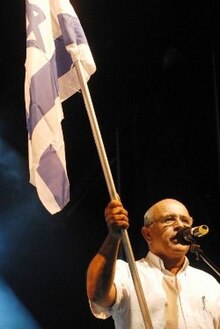Avigdor Kahalani
|
Tat Aluf Avigdor Kahalani |
|
|---|---|

Brigadier General, Avigdor Kahalani
|
|
| Minister of Internal Security | |
|
In office 18 June 1996 – 6 July 1999 |
|
| Prime Minister | Benjamin Netanyahu |
| Preceded by | Moshe Shahal |
| Succeeded by | Shlomo Ben-Ami |
| Member of the Knesset | |
|
In office 23 June 1992 – 17 May 1999 |
|
| Personal details | |
| Born |
16 June 1944 Ness Ziona, Mandate Palestine |
| Political party |
Third Way Labor Party (formerly) |
| Awards |
Distinguished Service Medal Medal of Valor |
| Military service | |
| Allegiance |
|
| Years of service | 1962-1992 |
| Rank | Brigadier General |
| Commands |
77 Battalion 7th Armored Brigade 36th Division |
| Battles/wars |
Six-Day War Yom Kippur War |
Brigadier-General (Tat Aluf) Avigdor Kahalani (Hebrew: אביגדור קהלני, born 16 June 1944) is a former Israeli soldier and politician.
Avigdor Kahalani was born in Ness Ziona during the Mandate era. His parents, Moshe and Sarah Kahalani, were Yemenite-Jewish immigrants originally from Sana'a. Kahalani studied mechanics at the ORT School in Jaffa. He gained a B.A. in History from Tel Aviv University and an M.A. in Political Science from Haifa University. He also attended the Command and General Staff College at Fort Leavenworth, Kansas, and graduated from Israel's National Defense College.
Kahalani was conscripted into the Israel Defense Forces (IDF) in 1962, and joined the 7th Brigade of the IDF Armored Corps. He later stayed in the IDF as a career officer, and achieved the rank of Brigadier General. Kahalani received the Medal of Distinguished Service for service during the Six-Day War, where he was badly wounded when his M-48 Patton tank caught fire. When the Yom Kippur War broke out in 1973, Kahalani was a 29-year-old lieutenant Colonel and battalion commander. He served as commander of the Centurion-equipped 77th Armored Battalion of the 7th Brigade on the Golan Heights. Kahalani's battalion – along with other elements of the 7th Armored Brigade – engaged in fierce defensive fighting against a vastly superior Syrian mechanized force, consisting of more than 50,000 men and 1,200 tanks. The battle proved to be one of the turning points of the war. After the war, the valley where it took place was littered with hundreds of destroyed and abandoned Syrian tanks and was renamed "Emek Ha-Bacha" ("The Valley of Tears"). For his actions during the war Kahalani received the highest Israeli military decoration, the Medal of Valor.
...
Wikipedia
